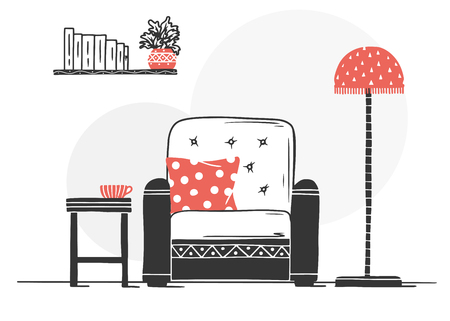Understanding Maximalism in British Homes
Maximalism, at its core, is about embracing abundance and personality in interior design—a striking contrast to the pared-back minimalism that dominated British homes for decades. In the UK context, maximalism isn’t just about filling rooms with objects; it’s a celebration of history, storytelling, and eclectic taste. British interiors have long reflected a tapestry of influences: from Victorian opulence and Arts & Crafts intricacy to the bold patterns of the 1960s and the global finds brought back from travels. This layered approach allows for mixing inherited heirlooms, cherished bric-a-brac, and vibrant textiles—each item often telling its own story. For couples and housemates sharing spaces, maximalism offers a way to honour individual identities while creating a home that feels inviting and lived-in. It resonates deeply with the British love for nostalgia, eccentricity, and curated clutter—a style where there’s room for everyone’s treasures. Whether you live in a Georgian terrace or a modern flatshare, maximalism invites you to break design rules and showcase what makes your home truly yours.
2. Balancing Personal Expression and Shared Spaces
Living in a shared British home—be it a charming Victorian terrace in London or a quirky converted flat in Brighton—means finding that sweet spot between self-expression and collective comfort. Couples and housemates often have distinct tastes, yet the heart of British maximalism lies in celebrating individuality while fostering harmony. Drawing inspiration from classic London terraces, where bold wallpapers mingle with heirloom teapots and mismatched armchairs, you can create a space that feels both personal and inviting.
Practical Ways to Balance Individuality and Cohesion:
| Strategy | Description | Example |
|---|---|---|
| Zone Personal Areas | Designate corners or walls for each person’s unique style, allowing freedom within boundaries. | A reading nook decorated with your favourite football memorabilia, next to your partner’s gallery wall of botanical prints. |
| Mix & Match Textures | Blend different fabrics, patterns, and colours typical of eclectic British interiors for layered interest without clashing. | Tweed cushions beside velvet throws, William Morris wallpaper behind pop art posters. |
| Rotate Decorative Items | Agree to swap out certain items seasonally or annually so everyone gets their moment to shine. | Displaying one flatmate’s vintage crockery set during spring, another’s collection of jazz records in autumn. |
| Create Shared Collections | Start a collaborative display that reflects both personalities, encouraging conversation and connection. | A bookshelf featuring each person’s top five reads or a hallway lined with postcards from mutual travels across the UK. |
Communication is Key:
Open discussions about what each person values will help prevent misunderstandings. Whether it’s a beloved Union Jack cushion or an inherited tapestry from Yorkshire, respect for sentimental pieces goes hand-in-hand with compromise. Set some ground rules for communal areas—perhaps agreeing no more than three statement pieces per room—or use classic British humour to keep things light when opinions differ. Ultimately, maximalism in a shared home is about layering stories and memories as much as objects, creating a lived-in space where everyone feels seen and heard.

3. Tips for Curating, Not Cluttering: Practical Maximalism
Maximalism in a shared British home doesn’t mean letting every knick-knack and charity shop find fill up every available inch. Instead, it’s about curating pieces that feel personal, storied, and intentional—while keeping harmony with your partner or housemates. Here’s how to master practical maximalism without losing sight of comfort or organisation.
Choose with Purpose: Select What Resonates
Begin by selecting decor that genuinely speaks to you both, whether it’s vintage teacups from a local car boot sale, framed gig posters from your student days, or quirky ceramics picked up on a Cornwall holiday. Prioritise items with shared stories or unique British flair over generic clutter. This not only makes your space meaningful but also ensures everything has a reason to stay.
Display Creatively—But Keep It Cohesive
Embrace layered shelves, gallery walls, or mantelpiece arrangements to showcase your finds without chaos. Group items by colour, theme, or era (think mid-century mugs beside 1970s Penguin books), and don’t be afraid to let each person claim a ‘zone’ for their personality to shine. Use trays, baskets, and shadow boxes for smaller pieces—very much in the spirit of British orderliness.
Rotate and Refresh Regularly
Resist the urge to put everything out at once. Instead, rotate collections seasonally or whenever you fancy a change—making room for new treasures from the latest jumble sale or antique market visit. This keeps the space fresh and prevents sensory overload. Store out-of-rotation items neatly in labelled boxes under beds or in cupboards, using classic British thriftiness to make the most of what you have.
Make Maximalism Organised and Meaningful
The heart of practical maximalism is intention: it’s not about how much you display, but why you choose each piece. By blending personal stories with clever storage and a touch of British resourcefulness, couples and housemates can enjoy a lively yet liveable home that reflects everyone’s character—without ever feeling cluttered.
4. Finding Common Ground: Joint Collections and Shared Interests
When two or more people share a home, especially in the context of British living where space is precious and characterful details abound, curating communal areas becomes both a challenge and an opportunity. Maximalism thrives not just on abundance but on meaningful layers—so why not layer your shared story right into your lounge or kitchen?
Jointly Curated Displays: Blending Personalities
Start by identifying items that reflect both your interests. For example, if one of you collects vintage Penguin books and the other loves local ceramics from weekend markets, bring these together for a visually striking display on open shelving or coffee tables. Consider rotating displays seasonally to keep things fresh.
Ideas for Joint Displays
| Type of Collection | How to Display | British Twist |
|---|---|---|
| Art prints & postcards | Create a gallery wall mixing each person’s favourites with local artists’ work | Include framed maps or prints of your favourite UK towns |
| Books | Arrange by colour or theme, interspersed with quirky bookends or personal mementos | Add classic British novels and regional travel guides |
| Local finds (pottery, antiques) | Cluster on mantelpieces, sideboards, or floating shelves | Feature pieces from car boot sales or charity shops for that authentic touch |
| Coffee & tea paraphernalia | Create an open beverage station with mugs, teapots, and jars of loose leaf blends | Proudly display Yorkshire tea tins or Cornishware pottery |
Layering Shared and Personal Interests in Communal Spaces
The key is balance—let each person’s style shine while maintaining cohesion. In the lounge, combine textiles: one might favour bold patterns, another subtle tweeds; together they create a uniquely British patchwork. In the kitchen, line up mismatched mugs above the kettle or hang aprons collected from different National Trust sites. The result? A welcoming space that sparks conversation and feels unmistakably yours—celebrating both individuality and togetherness in true maximalist fashion.
5. Room-by-Room British Maximalism
Living Room: The Heart of the Home
The classic British living room is often compact, with odd alcoves, bay windows, and perhaps even a stubborn fireplace that refuses to be anything but the focal point. To embrace maximalism here, layer in bold patterned cushions on your settee, mix-and-match throws over armchairs, and curate shelves with an eclectic blend of books, souvenirs from seaside holidays, and inherited china. Use ornate trays or vintage baskets to corral remotes and magazines—tidy but bursting with character. If wall space is limited, make a gallery wall above the mantelpiece, mixing contemporary art prints with family photos in mismatched frames for that signature ‘lived-in’ look.
Kitchen: Shared Chaos Meets Order
British kitchens can be notoriously small, especially in terraces or Victorian conversions. Here, maximalism means open shelving lined with colourful tins of biscuits, mugs collected from various counties, and glass jars filled with everything from Yorkshire tea bags to homemade chutney. Hang utensils on hooks above the hob and use magnetic strips for knives to save drawer space. Consider a pot rack suspended from the ceiling if headroom allows—a practical nod to country-kitchen style. For shared spaces, label shelves or baskets by person or couple to keep things harmonious amid the delightful chaos.
Loo: Small Space, Big Personality
The British loo—be it a tiny under-the-stairs WC or a shared bathroom—offers surprising scope for maximalist fun. Think bold wallpaper (florals or quirky prints), shelves stacked with interesting soaps and bath products, and baskets for everyone’s toiletries. Add hooks behind the door for robes or towels and don’t shy away from a statement mirror above the sink. A small window ledge is perfect for trailing houseplants or candles to keep things inviting despite limited square footage.
Hallway: First Impressions Count
British hallways are often narrow corridors squeezed between rooms, but they’re also prime real estate for showing off personal style. Layer runners in rich patterns along wooden floors and use slimline shoe racks or umbrella stands to keep clutter at bay. Wall-mounted coat hooks (labelled if necessary) help organise outerwear in multi-person households. Consider using the space beneath the stairs for decorative storage boxes—perfect for stashing seasonal scarves or footballs while keeping the entrance welcoming and distinctively yours.
Storage Hacks for Quirky Architecture
Maximalism doesn’t mean mess; it’s about intentional abundance. In homes with awkward nooks or eaves, custom shelving makes use of every inch while displaying treasured possessions. Ottoman benches offer hidden storage for blankets in shared living rooms; kitchen dressers double as both display and cupboard space. By working with Britain’s charming architectural quirks rather than against them, couples and housemates can each stamp their identity on communal spaces without sacrificing order—or comfort.
6. Resolving Style Clashes and Celebrating Differences
Even in the most harmonious British households, style clashes are almost inevitable when maximalism meets more than one personality. One partner may adore bold florals and vintage teapots, while another champions sleek mid-century lines and football memorabilia. Among housemates, the love of chintz could clash with a penchant for minimalist tech. Rather than letting disagreements simmer, it’s distinctly British to address these differences with gentle tact and a sense of humour.
The Art of the Cuppa Conversation
Navigating taste conflicts doesn’t have to be dramatic or divisive. In true British fashion, invite everyone involved to gather round for a cuppa—a warm cup of tea naturally sets a relaxed tone for honest discussion. Use this time to share personal stories behind favourite pieces or design choices; sometimes, understanding the sentimental value behind a kitschy lamp or a bold Union Jack cushion can soften resistance.
House Meetings: A Practical Tradition
For couples and housemates alike, scheduling regular “house meetings” can help keep everyone on the same page. These don’t have to be formal affairs—think of them as friendly catch-ups where each person can express what’s working (and what isn’t) in your shared maximalist space. Make sure everyone has a voice, from the avid collector to the accidental minimalist.
Finding Common Ground and Compromising
When opinions differ wildly, look for creative compromises. Perhaps dedicate one wall or corner to each person’s vision, or alternate who chooses soft furnishings seasonally—after all, changing up cushions and throws is practically a British pastime. You might even create “feature zones” that showcase contrasting styles side by side, turning potential clashes into lively conversation starters.
Celebrating Contrast: The Maximalist Advantage
Maximalism actually thrives on contrast and character. Rather than aiming for uniformity, see differences as an opportunity to tell a richer story about everyone living under your roof. Whether it’s displaying mismatched crockery in the kitchen or mixing up artwork on your gallery wall, use these juxtapositions to highlight the unique blend of personalities that make your home unmistakably yours—and unmistakably British.
In the end, resolving style clashes in shared maximalist spaces is about respect, open communication, and embracing eclecticism. So pop the kettle on, celebrate your differences over a biscuit or two, and remember: it’s these very contrasts that give your home its soul and warmth.


